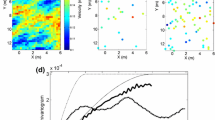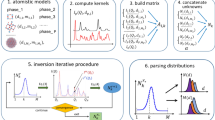Summary
{\rtf1\ansi\ansicpg1250\deff0\deflang1038\deflangfe1038\deftab708{\fonttbl{\f0\froman\fprq2\fcharset238{\*\fname Times New Roman;}Times New Roman CE;}} \viewkind4\uc1\pard\f0\fs24 The Center for Engineering Applications of Radioisotopes (CEAR) has been working for about ten years on the Monte Carlo - Library Least-Squares (MCLLS) approach for treating the nonlinear inverse analysis problem for PGNAA bulk analysis. This approach consists essentially of using Monte Carlo simulation to generate the libraries of all the elements to be analyzed plus any other required libraries. These libraries are then used in the linear Library Least-Squares (LLS) approach with unknown sample spectra to analyze for all elements in the sample. The other libraries include all sources of background which includes: (1) gamma-rays emitted by the neutron source, (2) prompt gamma-rays produced in the analyzer construction materials, (3) natural gamma-rays from K-40 and the uranium and thorium decay chains, and (4) prompt and decay gamma-rays produced in the NaI detector by neutron activation. A number of unforeseen problems have arisen in pursuing this approach including: (1) the neutron activation of the most common detector (NaI) used in bulk analysis PGNAA systems, (2) the nonlinearity of this detector, and (3) difficulties in obtaining detector response functions for this (and other) detectors. These problems have been addressed by CEAR recently and have either been solved or are almost solved at the present time. We have now finished the development of Monte Carlo simulation for all of the libraries except the prompt gamma-ray library from the activation of the NaI detector. We must first determine a treatment for the coincidence schemes for Na and particularly I to complete the Monte Carlo simulation of this last library. \par }
Similar content being viewed by others
Author information
Authors and Affiliations
Rights and permissions
About this article
Cite this article
Gardner, R., Zhang, W. & Metwally, W. {\rtf1\ansi\ansicpg1250\deff0\deflang1038\deflangfe1038\deftab708{\fonttbl{\f0\froman\fprq2\fcharset238{\*\fname Times New Roman;}Times New Roman CE;}} \viewkind4\uc1\pard\f0\fs24 Status of software for PGNAA bulk analysis by the Monte Carlo - Library Least-Squares (MCLLS) approach \par } . J Radioanal Nucl Chem 264, 221–228 (2005). https://doi.org/10.1007/s10967-005-0697-6
Issue Date:
DOI: https://doi.org/10.1007/s10967-005-0697-6




